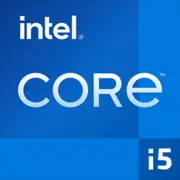Intel Core i5-1240P

Intel Core i5-1240P: A Versatile Processor for Mobile Tasks in 2025
Review of Architecture, Performance, and Use Cases
Architecture and Process Technology: The Hybrid Alder Lake Approach
The Intel Core i5-1240P processor, released in 2022, remains relevant in 2025 thanks to its hybrid Alder Lake architecture. It combines 4 performance cores (P-cores) with Hyper-Threading support (8 threads) and 8 efficient cores (E-cores) (8 threads), totaling 12 cores and 16 threads. This combination allows for task optimization: P-cores handle heavy computations (e.g., rendering), while E-cores manage background processes (updates, streaming).
- Intel 7 Process Technology (10nm Enhanced SuperFin): Improved transistor density and energy efficiency.
- Frequencies: Base frequency — 1.7 GHz, maximum turbo frequency — 4.4 GHz for P-cores.
- Integrated graphics Iris Xe (80 EU): Supports 4K displays, light gaming (e.g., CS:GO at medium settings), and accelerates AI tasks.
- Cache: 12 MB L3, which speeds up multi-threaded operations.
This architecture is Intel’s response to the growing demand for a balance between power and battery life in ultrabooks.
Power Consumption and TDP: 28 W for Balance
The 28 W TDP positions the i5-1240P as a processor for slim laptops with active cooling. Unlike the 15-Watt U-series, it offers higher performance but requires an effective heat dissipation system.
- Dynamic Management (Intel Dynamic Tuning): Automatically adjusts frequency and voltage based on load.
- Operating Modes: In power-saving mode, E-cores dominate, reducing consumption to 10-15 W. Under load, P-cores activate, which can briefly increase power consumption to 40-50 W.
Example: The Lenovo Yoga Slim 7i Pro laptop with this processor features a dual-fan cooling system, preventing throttling even under prolonged load.
Performance: From Office Work to Light Gaming
According to Geekbench 6 (1919 / 6964), the i5-1240P outperforms the AMD Ryzen 5 6600U (~1800 / 6500) in single-threaded tasks but slightly lags behind the Apple M2 (~2100 / 8500) in multi-threading.
- Office Tasks: Running 30+ tabs in Chrome, working with Excel (spreadsheets with 100k rows) — no lag at all.
- Multimedia: Converting 4K video in HandBrake (~35-40 minutes for a 10-minute clip).
- Gaming: In Fortnite (1080p, low settings) — 45-55 FPS; Dota 2 — 60-70 FPS.
- Turbo Mode: Peak frequency of 4.4 GHz lasts up to 20-30 seconds, stabilizing at 3.8-4.0 GHz afterwards (depends on cooling).
For streamers: OBS + game + browser — occasional minor stutters are possible, but overall stable.
Use Cases: Who Is the i5-1240P Ideal For?
1. Students and Office Workers: Multitasking (Zoom + documents + email).
2. Amateur Creatives: Photo editing in Lightroom, editing short videos.
3. Mobile Gamers: Games like Overwatch 2 or Genshin Impact on low settings.
4. Remote Workers: Stable work with cloud services and VPNs.
Not recommended for 3D modeling in Blender or streaming in 4K.
Battery Life: 8–10 Hours in Real Conditions
With a battery capacity of 60 Wh (e.g., Dell XPS 13):
- Web browsing: 9–10 hours.
- Video (YouTube, 1080p): 8 hours.
- Load (Photoshop + browser): 4–5 hours.
Power-saving Technologies:
- Intel Speed Shift: Fast switching between processor states.
- Adaptix Dynamic Tuning: Machine learning for load forecasting.
Tip: Disable turbo mode in power settings to extend battery life by 15–20%.
Comparison with Competitors: AMD, Apple, and Previous Generations
- AMD Ryzen 5 7640U (Zen 4): Better in multi-threaded tasks (~7200 in Geekbench 6 Multi), but pricier (laptops from $1000).
- Apple M3: More energy-efficient (12+ hours of battery life), but limited compatibility with Windows software.
- Intel Core i5-1135G7 (11th generation): Lags 30% in multi-threading, lacks E-cores.
Prices for laptops with the i5-1240P in 2025: $800–$1200 (e.g., Acer Swift 5 — $999, HP Envy 14 — $1099).
Pros and Cons
Strengths:
- Hybrid architecture for multitasking.
- Support for Thunderbolt 4 and Wi-Fi 6E.
- Competitive pricing in the segment.
Weaknesses:
- Heating under prolonged load.
- Lags behind Apple M3 in battery life.
Laptop Selection Recommendations
- Device Type: Ultrabooks (Asus ZenBook), business laptops (ThinkPad T14).
- What to Look For:
- Cooling system (at least 2 fans).
- Display: IPS or OLED with at least FHD resolution.
- Battery: at least 50 Wh.
- Ports: 2x Thunderbolt 4 for peripherals.
Avoid models with passive cooling — the processor will not reach its full potential.
Final Conclusion
The Intel Core i5-1240P in 2025 is an optimal choice for those searching for a balance between price ($800–$1200), performance, and portability. It is suitable for:
- Students for studying and entertainment.
- Office Workers valuing stability.
- Travelers needing a lightweight laptop with long battery life.
If you are not willing to pay extra for top models but want modern functionality — this processor is for you. However, for professional tasks (4K editing, AAA gaming), it may be worth looking into more powerful CPUs or discrete graphics.
Basic
CPU Specifications
Memory Specifications
GPU Specifications
Miscellaneous
Benchmarks
Compared to Other CPU
Share in social media
Or Link To Us
<a href="https://cputronic.com/cpu/intel-core-i5-1240p" target="_blank">Intel Core i5-1240P</a>